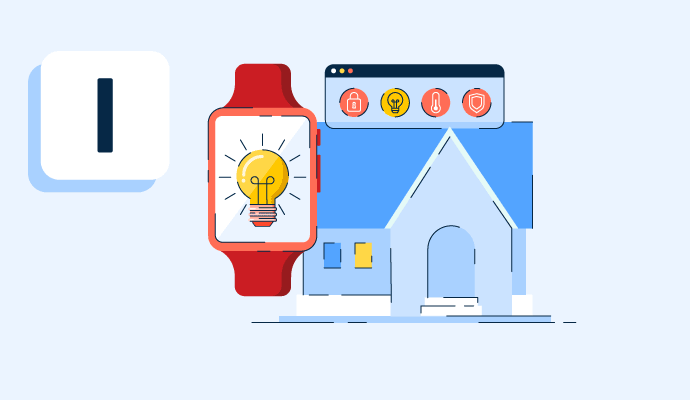What are IoT devices?
Internet of Things (IoT) devices are hardware instruments that collect and exchange data over the internet. These devices are programmed to run specific applications and can be embedded into other IoT devices.
IoT devices are part of an ecosystem where each device communicates with other similar devices to automate chores for home and business. Many businesses that use IoT devices adopt IoT device management software to track, monitor, and manage physical IoT devices.
IoT gadgets can transmit useful sensor data to consumers, companies, or any intended recipients. They can be divided into three primary categories: industrial, commercial, and consumer.
For instance, devices in a smart home like smart TVs, speakers, toys, wearables, and appliances detect and react to human presence. Someone's car interacts with the garage to open the door when they get home. When they enter, the lighting dims to a lower intensity and color based on data from their smartwatch; the thermostat is already set to their chosen temperature.
Components of IoT devices
An IoT device comprises various components that work together to collect data, process information, and communicate with other devices or cloud services. IoT device components can be categorized as:
- Data collection components are typically a sensor like radio frequency identification (RFID) or digital antenna, an optical or temperature sensor, or even a current-sensing electrical device. The sensing component's job is to capture data and turn it into numbers so a computer can process it.
- Data transmission components are often antennas. The transmitting antenna transfers gathered data to the platform for managing IoT devices, which manages the data gathered by all of the network's IoT devices.
- Data storage components may also be present in some IoT devices. However, they’re typically small. As IoT network data protocols are only built for low amounts of data, IoT devices retain data to manage network traffic.
How IoT devices work
IoT devices have different purposes, but they all operate in similar ways. IoT devices sense events occurring in the real world. They typically have an integrated central processing unit (CPU), network adapter, and firmware connected to a dynamic host configuration protocol server. It also needs an IP address to function over the network.
A software program configures and administers the majority of IoT devices, like when consumers use a smartphone app to manage the lighting in their house. Some gadgets don't require external programs because they include inbuilt web servers, for example, when the lights turn on as a person enters a room.
IoT device examples
Below are some common examples of IoT devices.
- Sensors. Sensors are one of the oldest and most common types of IoT devices. For example, there have been sensors in automatic street lights and temperature sensors for thermostats for a while.
- Security devices. IoT motion sensors are part of advanced security systems. Both individuals and organizations can monitor their respective homes or offices from anywhere in the world, even if the sensor is disarmed. It’s now easy to customize alerts, connect security devices to other smart devices, or even communicate with people who triggered the motion sensor.
- Smart home devices. Intelligent appliances rely on IoT devices to collect data and make essential adjustments. For example, smart home devices like speakers, intelligent light bulbs, smoke detectors, and smart door locks have become popular.
- Smart wearables. Some common wearables are fitness trackers and watches. Smart glasses and virtual headsets are also gaining a lot of attention these days. Most smart wearables focus on improving public health.
- IoT medical devices. These provide better medical diagnoses, treatment, and remote medical care. An example is internet-connected heart monitors and intelligent blood sugar sensors. These devices allow doctors to treat patients and obtain more accurate medical reports, even outside a traditional clinical setting.
- Industrial and logistics IoT devices. By tracking items and logging information like shipment weight, temperature, and route conditions, IoT technology can improve supply chain and logistics procedures. Businesses use Industrial IoT (IIoT) equipment for asset tracking, quality control, remote production management, and predictive maintenance. A company can look to IoT to track inventory, plan drone deliveries, track the present location of vehicles, and manage delivery routes.
- Point of sale (PoS) devices. Retailers and restaurants use IoT devices for PoS terminals. They make it easy for merchants to customize and digitize payment terminals, resulting in better customer experiences.
- Personal transportation devices. IoT powers personal transportation devices like electric scooters or electric bicycles that locals can borrow for a fee. In this case, SIM cards track the location of the device. The riders are then charged accurately for the distance they have ridden. Once the rider completes their ride, it’s left for another user to use.
IoT device concerns
IoT devices face two significant concerns:
- Security of IoT devices. Serious data breaches may result from an unsecured IoT device. Users must deal with security for IoT connections and secure IoT devices. Consumers frequently don't realize the need to safeguard these IoT tools, so they never configure the device's security or create a strong password. This leads to severe security vulnerabilities. A single connected IoT device links to numerous other devices, which amplifies this weakness and makes it possible for one insecure IoT device to jeopardize the security of the entire IoT network.
- Network security. It’s virtually impossible to keep all IoT devices on a network secure at all times. End users should focus on building IoT networks with device monitoring and security measures to restrict access from compromised machines.
IoT devices vs. edge computing
IoT devices are non-standard devices that can wirelessly connect to a network and exchange data. IoT devices extend internet connectivity beyond traditional devices like smartphones, laptops, tablets, and desktops. Businesses can now engage and communicate through networks.
Edge computing refers to a range of networks and devices close to the user. In reality, a significant driver of edge computing is the expanding IoT market. IoT devices produce massive volumes of data as more and more become connected. However, processing all of this data in the cloud might not be the best idea.
First, it can be expensive to transmit all data to the cloud. Second, transferring a lot of data to the cloud can result in bandwidth and latency problems. Instead of sending data to a centralized cloud thousands of kilometers away, edge computing processes data close to the source.
Edge devices conduct powerful analytics on the information at the network's edge and immediately give businesses the forecasts and solutions they need.
Learn more about IoT security to keep IoT devices safe against cyber attacks.

Sagar Joshi
Sagar Joshi is a former content marketing specialist at G2 in India. He is an engineer with a keen interest in data analytics and cybersecurity. He writes about topics related to them. You can find him reading books, learning a new language, or playing pool in his free time.





















